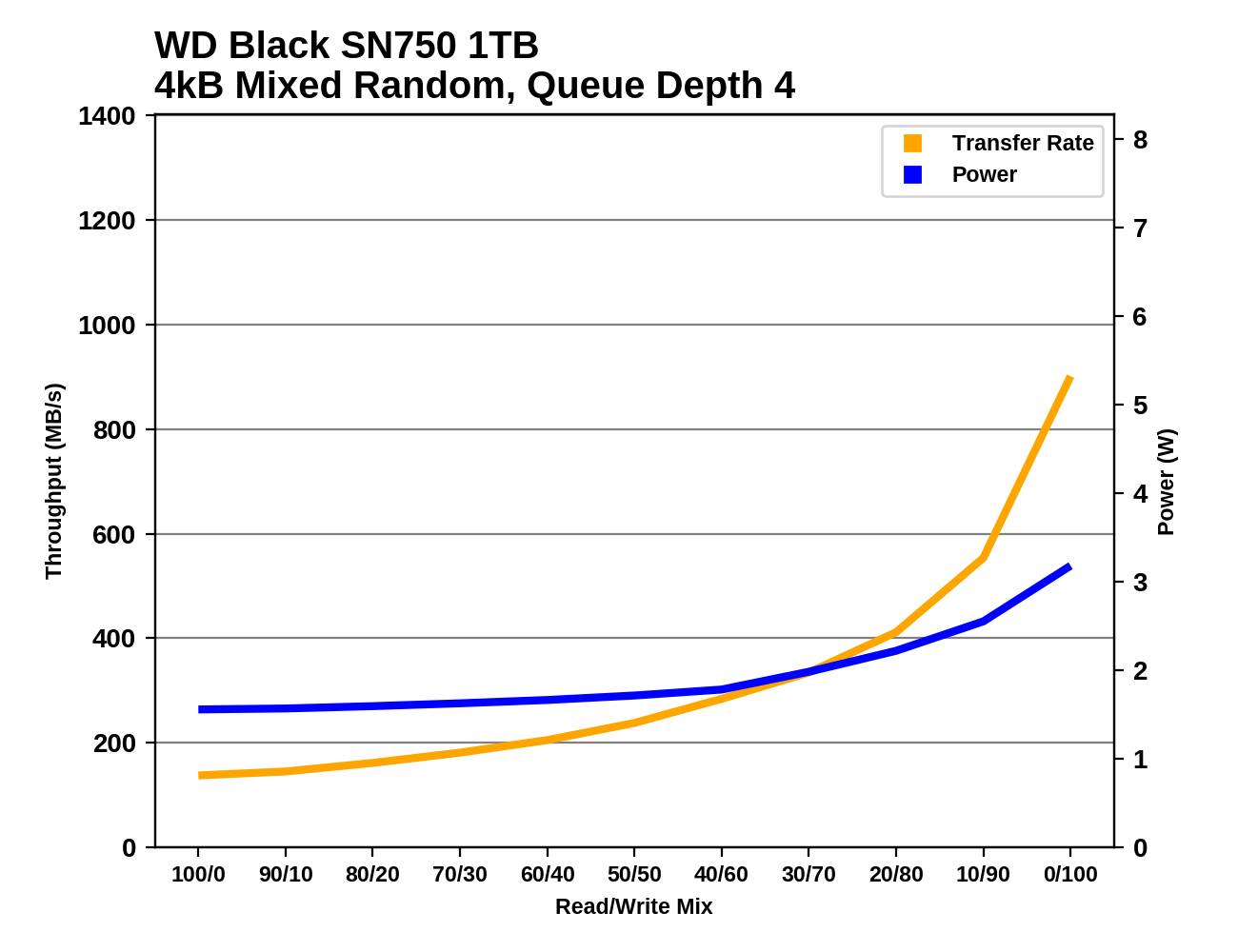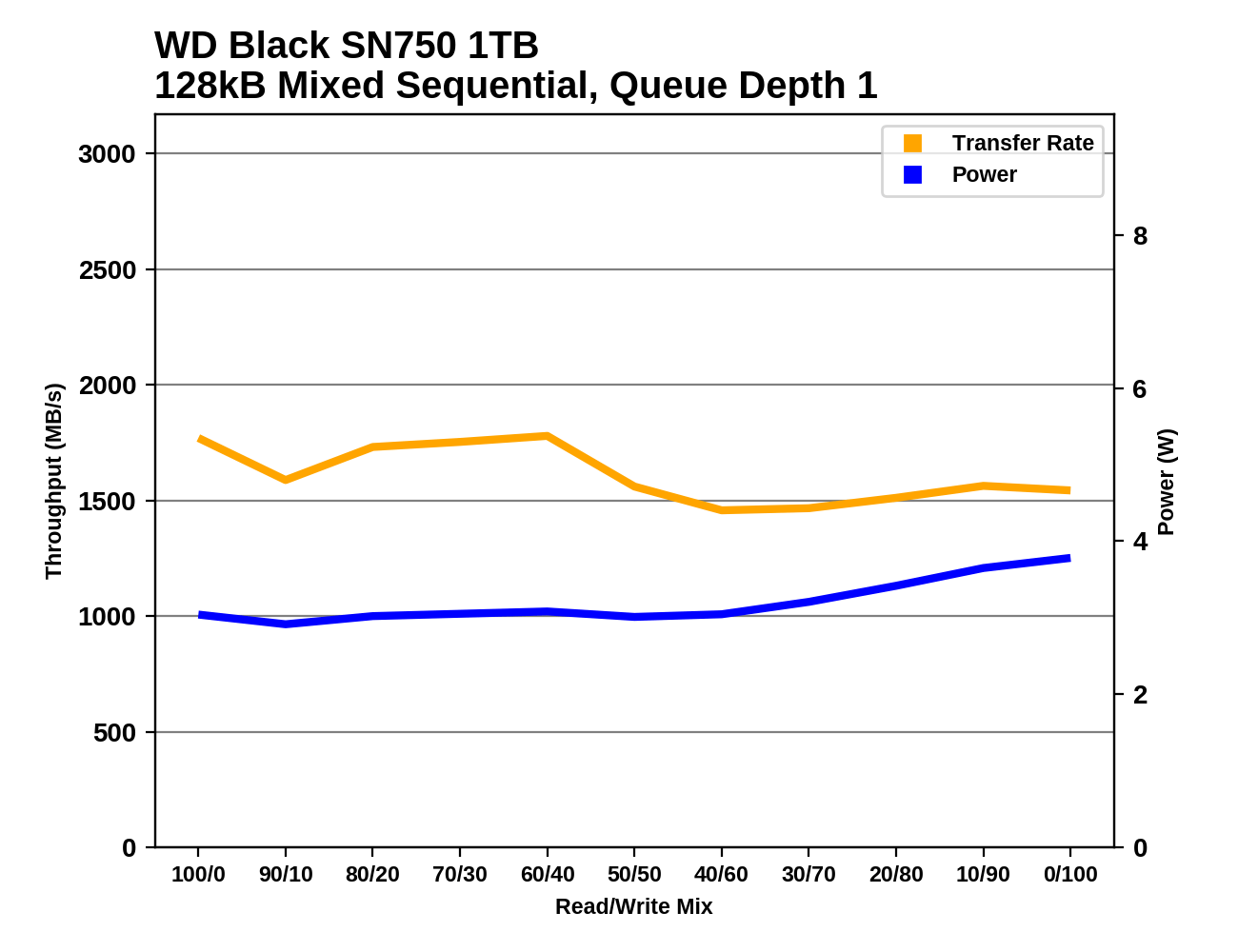The Western Digital WD Black SN750 SSD Review: Why Fix What Isn't Broken?
by Billy Tallis on January 18, 2019 8:01 AM ESTMixed Random Performance
Our test of mixed random reads and writes covers mixes varying from pure reads to pure writes at 10% increments. Each mix is tested for up to 1 minute or 32GB of data transferred. The test is conducted with a queue depth of 4, and is limited to a 64GB span of the drive. In between each mix, the drive is given idle time of up to one minute so that the overall duty cycle is 50%.

The overall mixed random IO performance of the Western Digital WD Black SN750 is about the same as the previous version, as well as the Toshiba XG6 and HP EX920. These are the second-tier drives that are a bit slower than the SM2262EN and the Samsung 970 EVO.
 |
|||||||||
| Power Efficiency in MB/s/W | Average Power in W | ||||||||
The SN750 and the Toshiba XG6 have almost exactly the same overall performance on this test, but the XG6 has 7% better performance per Watt. The second place score of the SN750 is still well above average—ignoring the outgoing WD Black, the SN750's performance per Watt is about 26% better than the next best TLC drive.
 |
|||||||||
The two flash-based drives that substantially outperform the SN750 on the mixed random IO test are faster through almost all of the test's phases, while the drives that are roughly tied with the SN750 tend to be a bit faster through the more read-heavy parts of the test and fall behind when the workload becomes very write-heavy.
Mixed Sequential Performance
Our test of mixed sequential reads and writes differs from the mixed random I/O test by performing 128kB sequential accesses rather than 4kB accesses at random locations, and the sequential test is conducted at queue depth 1. The range of mixes tested is the same, and the timing and limits on data transfers are also the same as above.

The WD Black SN750 improves upon its predecessor's performance on the mixed sequential IO test, but not quit enough to take the top spot on the performance ranking. The Samsung 970 EVO is a few percent faster overall.
 |
|||||||||
| Power Efficiency in MB/s/W | Average Power in W | ||||||||
The SN750 has a clear lead in the efficiency scores, improving upon the previous record set by last year's model that remained largely unchallenged, though the Toshiba XG6 and Corsair MP510 did come close. The average power consumption of the SN750 is slightly higher than the previous WD Black but that is more than offset by the higher average performance.
 |
|||||||||
The WD Black SN750 only barely drops below 1.5GB/s at its worst during the mixed sequential IO test, and it performs a bit better during the more read-heavy half of the test. The other drives all have worst-case performance that's slower than the SN750 by at least a few hundred MB/s, but many of those drives also have significantly better peak performance, most often at the read-heavy end of the test.










54 Comments
View All Comments
namechamps - Friday, January 18, 2019 - link
Strangely enough I don't think anandtech has ever reviewed the 970 Pro which is likely why it isn't in the comparison. They have done the 960 pro and the 970 evo but not the 970 pro.Ryan Smith - Friday, January 18, 2019 - link
"Whatever happend to the Samsung PRO in those comparisons?"Unfortunately Samsung never sampled the 970 PRO, so we don't have it on hand. And all indications are that they're just about done with it, having never released a 2TB version (like they did the 960 PRO).
I'm really not sure if we're going to see any new consumer MLC drives in 2019. The market has bifurcated into TLC and then more boutique solutions like Z-NAND and 3D XPoint.
althaz - Friday, January 18, 2019 - link
The 512Gb drive is a ~$150 part, just buy it and test it? To many this remains the most prestigious tech site around for at least some things. SSDs have been one of those things. Not having the latest of Samsung's pro drive in your results kinda makes this whole thing not worth it, IMO.If you need an excuse do a "MLC Redux" review where you look at what was probably the faster ever MLC drive and talk about how SSD tech has changed.
eldakka - Friday, January 18, 2019 - link
" just buy it and test it?"I'm sure anandtech would be delighted to test it if you sample one to them, or donate $150 to them to purchase one with.
GreenReaper - Saturday, January 19, 2019 - link
This is the level of a business expense though. Even if you did one a day for every day of the year it would be $53,400. OK, you could get a full-time journalist for that in some places, but that assumes they are kept and not sold on or used for anything else.Solandri - Monday, January 21, 2019 - link
More troubling is that unwillingness to buy a product for review smacks of demanding bribes. "Give us a free sample or we won't review your product." Which implies that companies which shower the reviewer with gifts will get more favorable reviews.Ideally, a review site should *never* accept free samples, and do all their product reviews with samples bought from the store. That's the only way to completely eliminate any undue influence the product manufacturer may have on the product review.
Dark_wizzie - Friday, January 18, 2019 - link
I don't think they actually reviewed the 970 Pro?StevoLincolnite - Saturday, January 19, 2019 - link
Yeah. Comparisons have been a bit crap on Anandtech lately.The RTX 2080 review is lacking a good lineup of GPU's to compare with... Despite promises of "Adding more later". (Never happened sadly.)
joesiv - Friday, January 18, 2019 - link
I would love to see at least some endurance testing in anandtechs reviews. I think it's something that's missing pretty much all SSD testing I see. Yes, speed is great, but endurance is something perspective owners will care more about in the long term.NAND technology is changing over time, is it changing for the better? More layers, but often at the expense of P/E Cycles.
SSD Firmwares as well have gotten both a lot more reliable, but also a lot more complicated, with different companies doing different things to maximize performance and also endurance.
Without testing these things, we don't know if there are duds in terms of firmwares/drives that don't strike a good balance between performance/reliability.
Bare minimimum I would love to see ananadtech do the following:
- Talk to manufacturers about the actual specifications of the NAND, what is the P/E Cycle rating for the NAND. Then list it in the specs for the drives so we can do our own research/homework if we want to. This spec is very often missed in the most marketing material.
- Do a quick capture of the SMART data at the very start of the testing
- Do a capture of the SMART data at the very end of your testing.
- Check out the Block Erase Count specifically. The Average Block Erase count would give a good approximation of how much life you've used just within your benchmark suite. It's much more grainular than Percent Life Used. This SMART attribute can vary between different manufacturer/firmware/controllers, so you might need to contact the manufacturer for this info.
In the end, you'll have something like: Rated P/E count / Average Block Erase, and since your test suite is likely pretty similar between SSD's, it would be a useful metric.
Bonus points, you could also look at NAND writes (not to be confused with Host Writes), during your testing, as it's related to life expectancy and can be corrolated with Total Byte Written.
I wouldn't be surprised to see that some drives write a lot more to NAND than you are expecting, and thus have higher Average Block Erases during your testing.
At my company when I did this test, while we were evaluating a drive for our products, Tier 1 memory manufacturers and their drives, failed bitterly at this endurance test where most did fine. I attribute this to the firmware. Working with the firmware developement team, we determined that the fix would not be feasible in that generation of product, so we had to skip that product.
Specs aren't everything, we need to test it, endurance is an important aspect, and I'd love to see it represented in your reviews.
romrunning - Friday, January 18, 2019 - link
Whom do you consider to be "Tier 1 memory manufacturers" - Samsung or Intel? I can't imagine their products failing endurance tests. Or are you talking about those you would consider to be lower than Samsung - like AData, Team Group, etc. - as a Tier 2 or Tier 3?